#and extended to a lot of other ‘edgy’ stories in the 90s and 2000s
Explore tagged Tumblr posts
Note
Any green lantern comic recommendations? Happened to watch the seemingly atrocious movie with the Fall Guy guy and yet I'm capital I Intrigued
love ryan reynolds being known as “the fall guy guy” instead of. i dunno. deadpool or whoever. anyway it kind of depends on what kind of comics you enjoy reading; green lantern’s been around in some form almost as long as superhero comics as we know them have existed, so really you just have to pick an era and go from there
- golden age (1938-1955) is where the first incarnation of the character debuted, he was the wielder of a power ring chosen by a mystical energy and the stories were about like… magical and mythological stuff, kind of based on old norse and persian legends. these are corny and kind of incomprehensible in the way a lot of 1940’s comics are but they alternate between serious and silly
- silver age (1956-1969) is the second incarnation of the character, this is what most people think of when they think of green lantern (and it’s also what the movie was about), with the character being reworked to be a sci-fi adventure hero that’s a member of an intergalactic police force; these books are also very corny but in a very charming and earnest way, i think. sort of like original star trek. when i say “it’s always something with this guy” about this period i mean it
- bronze age (1970-1985) is when they start introducing other human green lanterns from earth. there ends up being a couple of them running around at the same time and sometimes they work together and stuff. these are still occasionally goofy but we’re starting to dip more into the territory of people irl taking comics more seriously so you start to get stories that deal with stuff like race and class struggles. this is when we get a really classic green lantern/green arrow crossover run that’s essentially an extended political dialogue
- in-betweener age (1985-1999) is when superhero comics start to be Cultural Phenomena in the way we understand now. this is where we start to get way more of the big ambitious crossover events and huge paradigm-shifting crises and all that good stuff. further on into the 90’s you start to see the advent of the sort of x-treme edgy-for-its-own-sake crap that was du jour in the early 2000’s but it doesn’t quite hit its peak of annoyingness in this era so if you’re into more darker psychological stories OR big cosmic conflicts that don’t feel weightless this is the sweet spot
- modern age (2000-present) is where we are now. the wider green lantern canon got a big revamp around 2007 by a writer called geoff johns that involved a lot of retcons (some of it was cool, some of it was stupid. you can see his influence all over the 2011 movie). we’re up to seven green lanterns and a whole rainbow of colored power rings. some stuff is good but some of it can feel kinda MCU-ified which is a shame. a lot of DC stuff between 2011 and 2016 just kind of sucked as a rule and green lantern is no exception so i’d avoid that period but post 2016 you can kind of just jump in wherever since most of it’s still topical
once you choose an era to start with you can come back and i can give you specific books/years/authors for that period; there’s way too much to nitpick all of it at once but i’d love to give you more targeted recommendations
10 notes
·
View notes
Text
So after making my last post I decided I’d give my two cents on the other big run that most people point to as one of the golden standards for X-Men. This one’s a bit more fresh in my mind than Claremont, probably just due to the fact it’s much, much shorter. But I do have a ramble for this one too, don’t you worry.
Grant Morrison
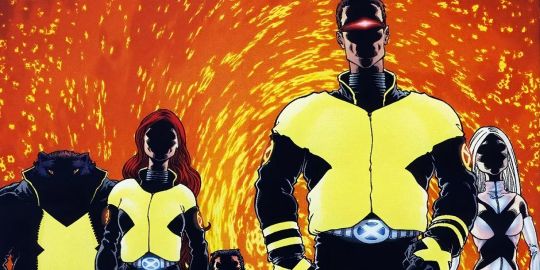
I love a lot of Grant Morrison’s work. They’re probably one of the most bonkers writers out there. I’ve read All Star Superman front to back multiple times, I’m currently thumbing through their JLA. I really wanna get into their Animal Man. Dunno if I’d vibe with Doom Patrol just because it may be a bit too insane even for my tastes. Only thing I’ve really avoided of theirs is Wonder Woman: Earth One. From what I’ve read it seems like a swing and a miss. Ironic, because I’m one of the few people nowadays who immensely cares about Wonder Woman’s comics.
And New X-Men carries Grant’s penchant for swinging for the fences, high concept sci-fi, fantasy, drama, what have you. I love that Morrison leaned into the angle that some Mutants don’t have powers that are useful or that they can hide.
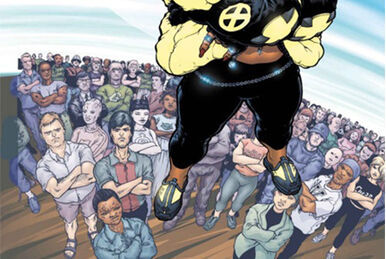
Sometimes your mutants aren’t conventionally attractive, and that’s great. They still deserve a chance to live! And I love that’s part of the narrative. It shouldn’t matter if you’re a mutant, it should matter who you are and what you do as a person.
Grant also leans into much more complicated ideas of romance and relationships, paving the way for the allegory of mutants to extend into LGBTQ+ lenses. The school is actually a school now! Professor X is more like the movies where he’s not really a conceited jerk who would drop the X-Men at the drop of a hat, but still comes in conflict with the newer generation.
Genuinely Morrison’s New X-Men is built upon ideas for a maturing, more complicated evolution of what Claremont was cooking.
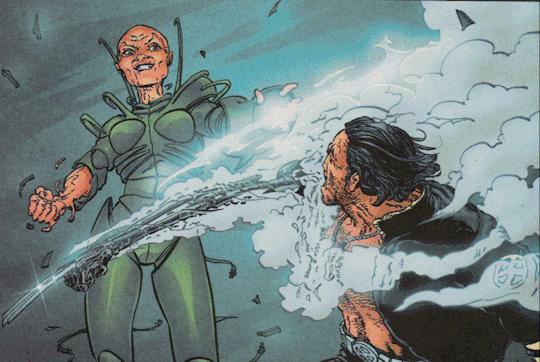
Mostly.
And there lies the problem that’s always stopped me from clicking with Morrison’s X-Men.
Grant Morrison and Mark Millar
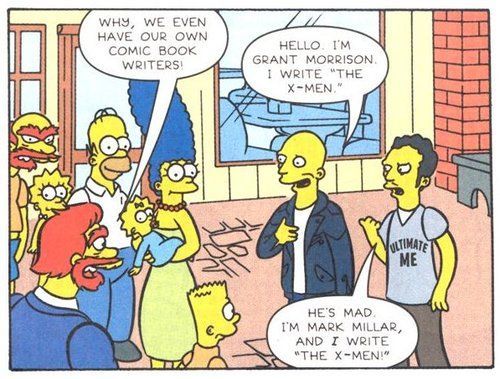
(Please note this surprisingly apocryphal gag was before Morrison preferred They/Them and came out as Nonbinary.)
Everybody has their edgy phase. At least I hope we do, would explain a lot.
Grant Morrison had a bit of a reputation in the 90s and 2000s as the big shot, new kid in town. They weren’t afraid to throw shade at Alan Moore, John Byrne, or really any of the old school comic veterans. They were here to play it out loud and in their own way.

They’d work very often together with Mark Millar, setting a real rebellious attitude with them. They weren’t afraid to be edgy, make crass jokes about toilet humor or stuff best left for the bedroom and doctor’s office.
And often times it worked. It wasn’t as though Morrison couldn’t reel it in to be serious like in JLA. But you don’t get a somber story about a cartoon coyote grappling with existentialism in a superhero comic from a normal joe.
Basically what I’m saying is, Morrison could be crass, but knew how to control it within the narrative. Something Mark Millar kind of struggled with.

I don’t have anything deep to really say about Millar and Morrison but they clearly were once conjoined at the hip. Once, being the key word seeing the quote above. But the irony is that when both writers were working on X-Men, it seems Morrison picked up some bad habits from their coworker.
A Dog-Kicking Intervention
Something I notice with Mark Millar’s writing is that he has a good structure for a story, the real great bones of something. However, when it comes to dialogue, it feels like he has to derail it by throwing in the most edgy, tryhard stuff to shock the reader. (The A does stand for frAnce, the fr is silent.) Either that or it’s just kind of blatant soap boxing of these characters without really understanding their history. There are many series that feel like this to me, like Marvel Knights Spider-Man, Civil War, Fantastic Four.

Unfortunately that kinda bled into Morrison’s work, and I feel their New X-Men suffers as a result.
New X-Men has some really brilliant ideas, but it also can be unreasonably cruel and edgy in a bad way. And that’s not to say that it’s due to the themes, as it deals with very heavy stuff like Genocide and PTSD. Some topics do have to be approached even though they’re brutal.
No, a good example would be Ugly John. Ugly John is introduced in the opening arc, E is for Extinction. A brutal story about how millions of mutants die in Genosha due to Cassandra Nova attacking with Sentinels. Wolverine, Cyclops and Ugly John are sent to stop Nova while the rest of the X-Men perform triage.

Ugly John doesn’t have any powers. He doesn’t have any skills. He has three faces. He’s not actually here because he has a purpose. He’s ugly. He’s not even named Steve. That’s the joke. That’s the joke Morrison makes over and over to try and undercut the gravity of the situation.

Then he dies.
What was the point of Ugly John? To fit in a dark moment, not really adding a point besides “wow life sucks doesn’t it?”
That’s probably the biggest thing that sours me on New X-Men. It doesn’t really have the confidence to fully recognize the seriousness of its material and that it doesn’t need any edge to further make a point. Reality is edgy.
And so I feel like this sort of lack of nuance kinda brings down the run. It never feels fully confident that it should be discussing these topics with nuance, so it has to throw something in for the South Park crowd.
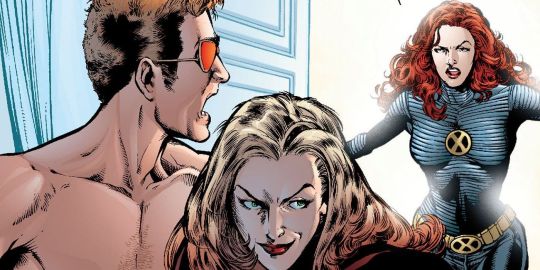
Cyclops is nervous about how long Jean and him have been in a relationship for? Well obviously it’s gotta lead to him and Emma making a big affair in bed.
A mutant is developing her powers suddenly and is kicked out of her family? Her powers should be a gross out parallel to morning sickness so her dad thinks she’s pregnant, and she’s a gross stereotype of black people living in the south.
A toddler mutant is being killed by their parents so that they don’t have to live with a mutant? Let’s make a couple of jokes about how the mutant ate a dog.
Jean Grey confronts another mutant who’s able to make illusions that confuse even her? The other guy makes a remark that she wants to sleep with him even though it’s never hinted before and just used so he can escape.
You see what I mean?
It doesn’t really feel like this stuff is in service to the serious plot, it’s just kinda mean-spirited without much actual narrative purpose. Sometimes it’s even derailing the point that Morrison is trying to make. Like Emma Frost’s PTSD is undercut entirely by how inappropriate she acts towards her students, so she comes off as unintentionally unsympathetic. Or Cyclops’ anxiety isn’t given room to breathe and acknowledge that he doesn’t consent to her advances.
Therefore it just comes off as Morrison kicking the dog for no reason.
It just really disappoints me because Morrison is such a skilled writer. But New X-Men fell within that edgy phase and it makes it hard to enjoy the concepts they come up with.
#grant morrison#jean grey#emma frost#cyclops#wolverine#uncanny xmen#new x men#mark millar#rant#ramble#comic books#marvel#marvelcomics#charles xavier#magneto#xorn#dark phoenix#xmen#rambles#ramblings
15 notes
·
View notes
Text
Research: History of Webcomics
From 1985 to 1992 (the stone age of webcomics), the people who were able to create and access webcomics were really only computer tech students, as they were the only people with internet access. Most comics were 3-4 panel, black and white strips- nearly identical to those found in newspapers. The oldest webcomic- Witches in Stitches, was one of these, and marked the beginning of webcomic creation. The comic itself was a Wizard of Oz parody strip distributed on CompuServe (the first major service provider in the US).
By 1993, distinct genres began to arise- computer/tech strips, gaming strips, and geek-interest strips (usually rich in sci fi references). However, now some people were beginning to play with the possibilities of the format. “Argon Zark!” by Charley Parker 1995 was full-colour, visually experimental, and animation embedded (and probably fell into the geek-interest category). And he wasn’t alone- Jesse Reklaw’s “Slow Wave” (1995) latched onto a smart, but simple premise- readers would email in descriptions of their dreams and Reklaw adapted them into 4-panel strips- a concept that would be nigh impossible without the instantaneous communication of the web, and it presaged the importance of reader/creator back-and-forth communication in the world of webcomics. Around 1996, as the online population reacted a crucial event horizon, webcomics exploded. Suddenly you could make money from them. Newspaper style strips continued to dominate, but now emerged a new genre of ongoing serial adventure strip (usually fantasy or sci fi) began to emerge. New art styles surfaced. Manga-influenced art began to appear in the late ‘90s following the popularity of anime such as “Sailor Moon”. The most notable webcomic like this was “Megatokyo” by Fred Gallagher and Rodney Caston. Sprite comics like “8-Bit Theater” and clip art comics like Ryan North’s “Dinosaur Comics” or “Wondermark” made people realise that they didn’t need to be able to draw well to be webcartoonists. The first real boom in webcomics climaxed with the publication of Socc McCloud’s book- “Reinventing Comics” in 2000, which devoted a sizable chunk of it’s pages to what he saw as 3 areas in which computer technology and comics could intersect- digital publication, digital delivery, and digital comics. Reception was mixed but McCloud was right in all the areas that counted; comics and computers were becoming increasingly inseparable. “Reinventing Comics” ushered in a flow of new webcomics and experimentation. Patrick Farley launched Electric Sheep Comics, a website for his many experimental comic projects. In 2002, Cat Garza began “Cuentos de la Frontera”- a collection of Hispanic folk tales and urban legends adapted to explored McCloud’s idea of the online “infinite canvas”. In 2001 Justine Shaw published her entire longform comic “Nowhere Girl” in a single chunk, in pages formatted to fit the web, which inspired a wave of online graphic comics. Around the same time, a loose group of cartoonists calling themselves “Pants Press” launched a substantial series of smart, engaging, and popular longform comics- all the more impressive when you realise that with the exception of one, the people involved were all teenagers. Autobiographical work became another popular frontier amongst the webcartoonist community. Often it was mixed with comedy and fantasy elements to make it more digestible. Part of what was so appealing about webcomics was that self-publishing allowed people to explore topics and genres that classic publishers would not be interested in. The most popular comics tended to be gag strips about nerd interests. Comics about video games tended to outstrip all else in popularity, with “Penny Arcade” and “PvP” standing atop the pile of lesser (yet enormously successful) “two gamers on a sofa” strips. In fact as the 200s wore on it became increasingly clear that gaming strips were simply the most prominent example of a larger trend in webcomics: special-interest niche strips. On of the most successful comics of the era (“Unshelved”, started 2002) was a strip about librarians. The jokes might only be funny to people who work at bookshops and libraries, but a lot of people worked at bookshops and libraries and everyone who did read “Unshelved”. Often this kind of thing was what proved to be most successful. One of the most widely-read comics even today may be XKCD (2005)- the holy grail of obscure maths and physics jokes. During this period, web and print began the feed from each other. If a comic wasn’t successful in print (most small publishers began to lose their footing with the rise of the internet) it could be published online for a fraction of the price, and likewise, if a comic was successful online it’d often be put to print. In 2007, the website MS Paint Adventures was launched by Andrew Hussie. Despite the name, most of the comics were created in Adobe Photoshop, as Hussie decided after the second page of the first page of the first comic that using MS Paint was simply not feasible. The webcomics published there relied (like some of it’s predecessors such as “Slow Wave”) on reader input- the first 3 adventures “Jail Break”, “Bard Quest”, and “Problem Sleuth” took the first suggestion from readers to drive the plot forward. This was also the case with his 4th adventure- “Homestuck” for a short while before the erratic suggestions caused the story to become "too unwieldy and made it difficult...to tell a coherent story”, after which Hussie switched to controlling the main plot himself. The comic itself inspired a new format of storytelling amongst the community of “extended adventure” webcartoonists, and spawned a number of other webcomics such as “Ava’s Demon” by Michelle Czajkowski, “Prequel” by Kazerad, and “NEOKOSMOS” by Amber & Shelby Cragg, as well as all the fan-comics on the official fan site- MS Paint Fan Adventures. Today, strip webcomics are increasingly moving off the web, and are adapting to social media. Edgy, and dark-humour comics such as “Cyanide and Happiness” are becoming more frequent and a bigger emphasis is placed on accessibility- moving them onto Facebook and iPhone-compatible websites and apps for example.
1 note
·
View note
Text
I’m just explaining how i first became familiar with this trope if it’s extended to just love interests in general then that’s totally understandable as definitions can change and more diverse writers have been putting themselves out there and getting fandom attention since the 2010s but i first heard the term in a feminist context to describe a more specific phenomenon to describe an extremely specific gendered relationship dynamic that was EVERYWHERE in comics in the 90s and extended to a lot of other ‘edgy’ stories in the 90s and 2000s extending far beyond comic books imo a lot of gwen stacy’s recent development has been a conscious attempt by witers to try to push the industry beyond this trope and you can’t get the full context of spiderverse gwen’s significance without understanding how fridging factors in as i think a lot of the ‘darker and edgier’ stories were trying to capitalize off the pathos of gwen’s death without really understanding how it worked or being willing to develop the love interest at all like how the ‘i forgot i murdered my wife’ trope was EVERYWHERE in indie horror after the smashing success of silent hill 2 but there are also examples of this trope in other industries that exist independently of american comics that still illustrate a problem with misogyny in the entertainment industry internationally like you see this trope pop up in anime sometimes it even showed up in the most recent zelda game it’s everywhere and it’ll probably exist for as long as the patriarchy exists which is why it’s important to know how to spot it but also to understand the difference between fridging versus a character death that’s not misogynistic or dehumanizing to the deceased as after we had conversations about this trope in fan and media spaces a lot of writers have been pushing back against this trope even in stories that do discuss the death of a woman steven universe being one of my favorite examples because of how well done rose’s posthumous character arc is
me tryna explain the difference between "fridging" and "death by origin story" and "character dies and that impacts other characters and that's not a bad writing decision"
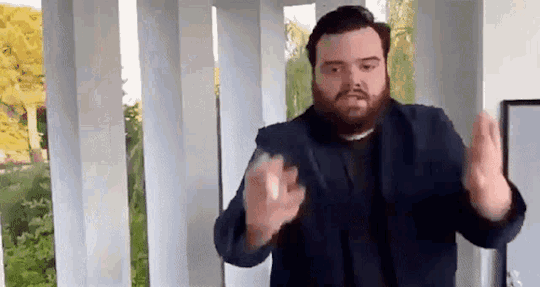
11K notes
·
View notes